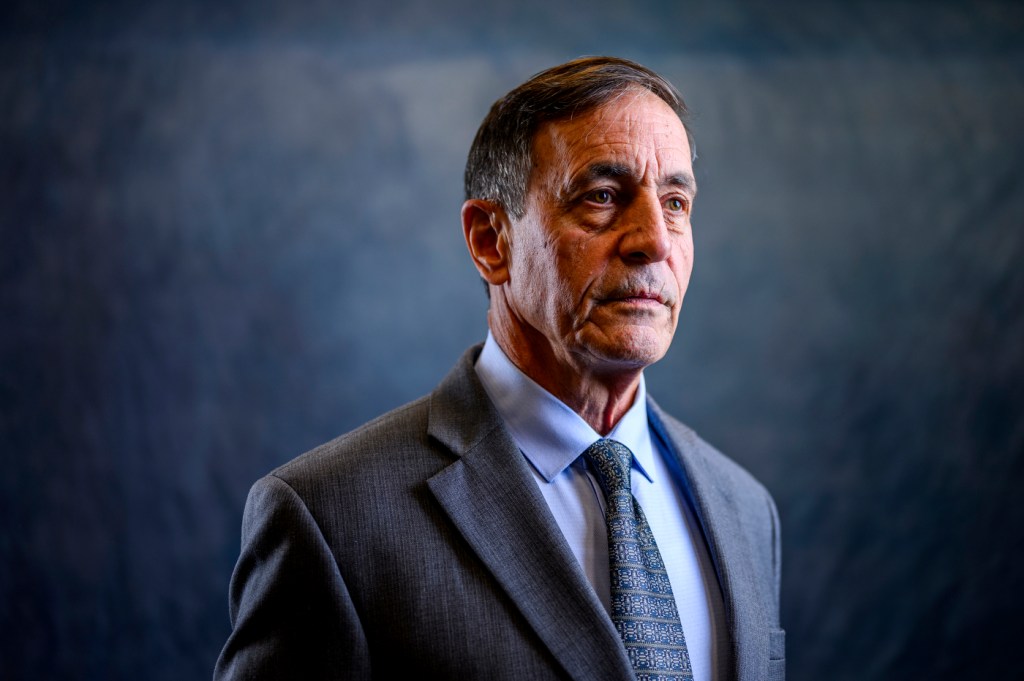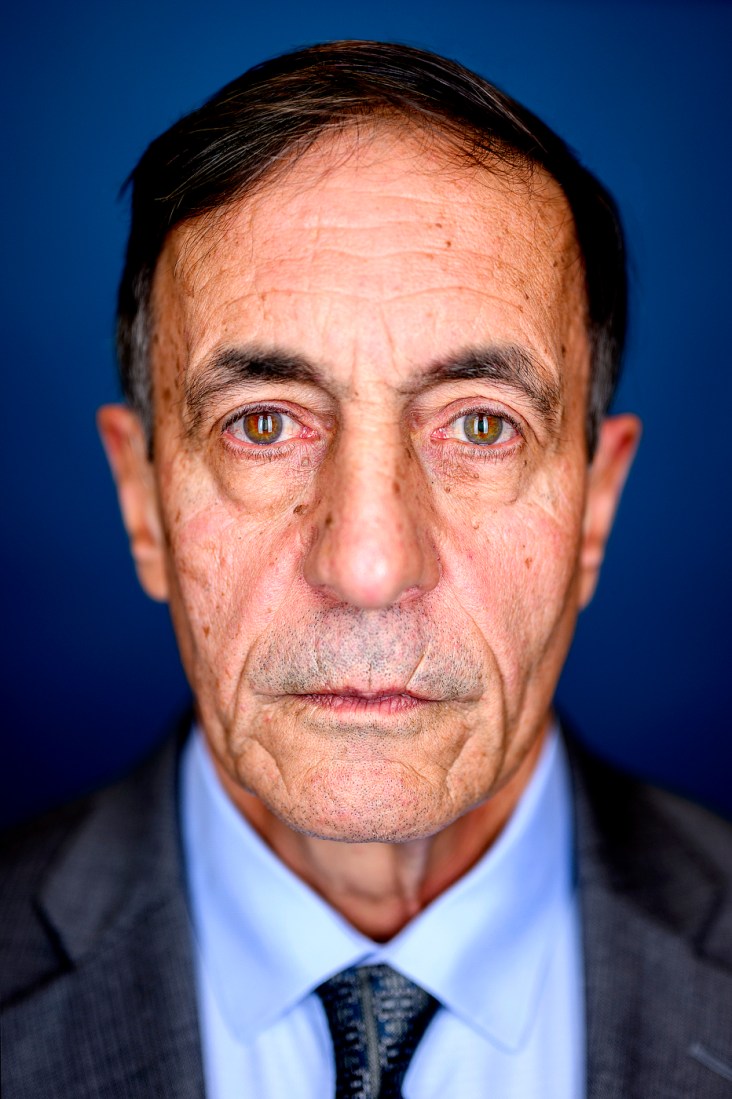Published on
Five decades after his graduation, a legendary general returns to Northeastern as an inductee into the ROTC Hall of Fame
Major Gen. Salvatore Cambria, who led U.S. Army Special Forces operations around the world, retired in 2012 after a highly decorated career of 36 years.

Salvatore Cambria, a retired U.S. Army major general, had not visited Northeastern University since he graduated with a biology degree in 1976.
On Friday, he made his return while receiving an unprecedented honor. Maj. Gen. Cambria was inducted into the United States Army Cadet Command Hall of Fame — the first Northeastern graduate to be so recognized.
Cambria retired in 2012 after a highly decorated career of 36 years.
After serving in the U.S. Army Infantry for five years, Cambria completed the Special Forces Qualification Course as an honor graduate. He spent his last 31 years in uniform as a Special Forces officer at different levels of command.
As the first Special Forces officer to lead two regional commands, Cambria served as commanding general, Special Operations Command South (overseeing South America and Central America) as well as commanding general, Special Operations Command Pacific (covering Asia and the Pacific theaters).
“Special Operations Forces are involved in various types of missions ranging from peacetime to combat, including unconventional warfare, short-duration strikes, special reconnaissance, counterterrorism operations, hostage rescue, civil affairs and foreign humanitarian assistance,” says Cambria, who was responsible for deploying and employing Special Forces (also known as Green Berets) and Special Operations units made up of Navy SEALs, airmen and Marines. “We have highly specialized civil affairs units that work with local governments and civilian aid organizations to rebuild infrastructure — schools, wells, medical clinics and orphanages — and restore stability in areas stricken by war or natural disasters.”
The Special Forces under Cambria’s command were known as Green Berets; SEALs and others under Cambria’s command were known as Special Operations units.
“Whether it’s training a counterterrorism force in a country or getting bad guys or conducting those civil affairs programs — I think these are all tremendous achievements.”
And yet Cambria did not envision a career in the military when he enrolled at Northeastern in 1971 amid the Vietnam War and the nationwide protests it prompted.
“I wanted to be a doctor,” he says.
In his own words, here is Salvatore Cambria’s story.
The Reserve Officers’ Training Corps (ROTC) enabled Cambria to graduate from Northeastern.
“I’m first-generation American. My mom and dad came over on a boat from Sicily right after World War II. I grew up in Roslindale, Massachusetts.
“My dad was a barber. He used to cut hair for a number of players from the Celtics, the Boston Red Sox and the Bruins hockey team. My dad died when I was in high school.
“Pretty close to the end of my first year at Northeastern, my mom said, ‘I’m out of money. I can’t pay for your school. I just don’t have it.’
“What was I going to do? I was talking to a good friend — he was not in ROTC but he knew about it — and he said, ‘Sal, go talk to the ROTC department. They give out scholarships.’
“Do you know what I said? I said, “What is ROTC?” Because I didn’t know. I didn’t grow up in a military family. So I went over to the ROTC department and I ended up getting a scholarship for the last four years.”
Today Northeastern heads Liberty Battalion, an 11-school Army ROTC consortium of 95 cadets, most of whom are on scholarship. While ROTC programs were exiled from many college campuses during the Vietnam era, ROTC maintained a presence at Northeastern. “A lot of the alumni are really proud of that,” says Col. Brian Slotnick, who heads Liberty Battalion.
“I remember there were protests. There were a couple of times we were told not to wear uniforms on campus. That went on for a few months at a time. I think there were only 30 to 35 cadets in my graduating class.”
Cambria transitioned from medicine to the military at Northeastern.
“I wanted to be a surgeon because it fascinated me to be able to put your hands inside a human body and to see the immediate results of your actions where eventually that person walks away and is healthy. I thought of that as an amazing challenge that was almost unreal.
“For me, being a member of the U.S. Army Special Forces fascinated me as both an intellectual and a physical challenge. Special Operations is where courage meets precision. These elite Special Forces units operate in the shadows, executing missions with unmatched skill, resilience and dedication.
“There were two to three cadre members at Northeastern who were Green Berets when I was a cadet. Throughout the year they would take us for a weekend of training with a Special Forces unit that was stationed at Fort Devens (in Massachusetts). I had the opportunity to learn a lot about the U.S. Army Special Forces and it became what I wanted to do following my commission to second lieutenant. Their standards are a lot higher than the regular Army because Special Forces is a volunteer organization — you have to apply and volunteer to go to training. And if you do not meet the standards, you will be transferred back to the regular Army.”
He graduated from Northeastern as a distinguished military graduate/distinguished military student and was commissioned on Sept. 16, 1976, in the infantry as a second lieutenant.
“I applied for Special Forces and kept getting turned down. I finally got accepted in my fifth year of service and stayed with Special Forces for the rest of my career.
“One of the biggest things I learned in the military as I was going through the ranks was to take care of your troops and always set the example in everything you do. Because the more rank you get, the more people are looking at you. But as a lieutenant, very few people are looking at you. I know, there are a lot of jokes about lieutenants, but everybody has to start somewhere, right?”
His command helped Colombia develop an enduring security network against an insurgent group known as FARC, the terrorist organization that dominated the nation’s drug trade.

“As a colonel, I was selected to command the 7th Special Forces Group, which mainly operated in Latin America, including Central America and the Caribbean.
“We were the first U.S. military unit to deploy to and help the Colombian government under Plan Colombia, a U.S. foreign aid, military aid and diplomatic initiative aimed at combating Colombian drug cartels and left-wing insurgent groups in Colombia. The plan was conceived by the administrations of Colombian President Andrés Pastrana and U.S. President Bill Clinton, and signed into U.S. law in 2000.
“The FARC would go to a farm and say, ‘If you grow cocaine for us instead of coffee, we’ll take good care of you … and if you don’t, we’re just going to kill you and your family.’ We went into one village where they wiped out a whole family — women, children — because they refused to grow cocaine.
“This operation continued for many years and Plan Colombia is a success story. Since Plan Colombia began, homicides in Colombia have been cut in half, while kidnappings and terrorist attacks have declined by 90%. As of February 2024, the vast majority of former FARC members have honored the 2016 peace agreement.”
Just before Cambria retired, he was directly involved in the mission to rescue Jessica Buchanan, an American aid worker, and Poul Hagen Thisted, a Danish aid worker, who had been held hostage by Somali pirates for 93 days.
“The pirates were demanding a $45 million ransom for their release. Precise intelligence as to their exact location along with concerns about Buchanan’s rapidly declining health were major factors in moving forward with the rescue mission. Under the cover of darkness, a Special Operations unit parachuted 19 kilometers from where they were being held and moved cross-country to conduct the rescue. Nine pirates were killed during the operation, and Buchanan and Thisted were successfully rescued, unharmed.”
He learned to deal with high-risk missions.
“In Special Operations, virtually everything we do is high risk. We accept that. But we mitigate the effects by developing and implementing numerous controls — actions taken to eliminate a hazard or reduce risk. Approval of Special Operations missions is often dependent on the presence of these controls. Without them, missions may be delayed or canceled altogether.
“I never really thought about the dangerous side of it because I always felt confident with our risk-mitigation procedures. You have to have confidence in your tactics, techniques, equipment and in the leadership. That is the bottom line.”
How did the mentality change after 9/11?
“That is a great question because up until 9/11 we were focused on one thing: the Russians coming across the Fulda Gap. The Fulda Gap offered one of two obvious routes for a hypothetical Soviet tank attack on West Germany from Eastern Europe, especially from East Germany; the other route crossed the North German Plain.
“The concept of a major tank battle along the Fulda Gap became a predominant element of NATO war planning during the Cold War.”
“It was all we were focused on. There was little to no focus on counterterrorism. There was no focus on nation-building and getting the militaries of other countries up to a level where they could handle their own problems of terrorism and have effective counterterrorist units.
“But 9/11 changed our myopic focus on the Russians. Everything changed to the better — the tactics, techniques, procedures, training and the organization of units. The mentality of the U.S. military completely changed as we focused on the Global Military Campaign referred to as the Global War on Terrorism.”
Cambria’s goal was to retire after 40 years.
“They called from the Pentagon and said, ‘You’ve done a great job. We don’t have any more jobs for you.’
“I said, ‘Can you send me to Afghanistan for my last year?’
“They said, ‘No, you’ve done enough in 36 years. Time to go home.’
“You’re probably thinking about asking me if I have any regrets. I really don’t have any regrets. I do wish I was still in most of the time because of what’s going on in the world today. Once you’re part of the team and you’ve played in the big games, it’s very hard to sit back and watch the games. You still want to be actively involved.”
Cambria, who had been inducted in 2022 into the Distinguished Member of the Special Forces Regiment Hall of Fame, brought family members, an ROTC classmate and a former aide de camp to the induction ceremony at Northeastern. His 10-person guest list included his wife, Jana, who retired as a senior non-commissioned officer after 35 years in the Army. They have three children.
“You read about people being inducted into a hall of fame, whether it’s sports or military or whatever it may be, and you sit back and say, man, that must be pretty cool. And all of a sudden it hits me. Wow. I’m being inducted into a hall of fame.
“I never expected that. So it’s truly an honor, an unexpected honor. It’s a recognition by an organization that takes the time to say, “You trained with us from day one, you had a great career and now we want to close that chapter of your life by honoring and thanking you for a job well done.” That’s how I look at it.”
Ian Thomsen is a Northeastern Global News features writer. Email him at i.thomsen@northeastern.edu. Follow him on X/Twitter @IanatNU.





